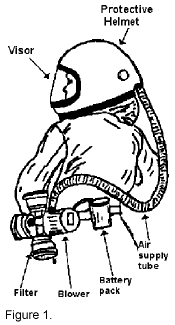 Concern for applicator safety has increased during the last
few years as more information on the effects of pesticides
on the body become known. As awareness increases so has the
development of better protective equipment. One of the most
recent developments is the pesticide protective helmet that
provides filtered air under positive pressure (see Figure
1).
Concern for applicator safety has increased during the last
few years as more information on the effects of pesticides
on the body become known. As awareness increases so has the
development of better protective equipment. One of the most
recent developments is the pesticide protective helmet that
provides filtered air under positive pressure (see Figure
1).
The helmet overcomes common problems with other face protection. Face masks and respirators frequently leak as they do not readily adjust to fit all sizes and shapes of heads. For workers with eyeglasses, beards, mustaches or long hair, a tight seal is almost impossible. The protective helmet on the other hand protects the head, nose, eyes, mouth, ears and respiratory system.
Weighing from 2 to 4 pounds, the helmet is molded of fiberglass usually with a double shell to give air distribution to the face area. Suspension on the head is from an adjustable band. Some manufacturers provide a chin strap to help stabilize the helmet so that it moves with the head.
Wide angle vision is provided through a clear face shield. Made of tough polycarbonate, the shield is abrasion resistant and impact proof.
Air is supplied to the helmet through a flexible hose from a blower unit that is worn on a belt. Air flow is regulated with several motor speeds on the blower. Helmet models for greenhouse application operate on battery power. Some manufacturers use rechargeable nickel-cadmium batteries with a 4 to 8 hour operating cycle. These will give about 2 years of service under normal use. Others use a sealed lead-acid battery. A charger that connects to a 115 volt power supply is included with the unit. Where the pesticide application is limited to operating field sprayers such as in nursery operations, one manufacturer (KASCO) supplies a unit that is powered by the tractor electrical system.
The filter is the heart of the system. The A/P filter, standard for most systems, can be used in areas where organic vapors, pesticides, dusts, fumes and mists are being applied. It consists of two parts. The gas filter (A) excludes organic vapors and pesticides. The dust portion (P) excludes dusts, aerosols and mists. Other filters are available that can be used with inorganic vapors and specific chemicals. There are no filters available for use in atmospheres containing fumigants, car on monoxide, natural gas or against organic vapors which generate high heats of reactions.
Manufacturers have their units tested to met NIOSH (National Institute for occupational Safety and Health) standards. Be sure the unit that you purchase has this approval. The cost for most systems is from $500 to $600.
USING THE HELMET
To keep the protective helmet system in good operating order the correct storage and maintenance procedures should be followed. After use the helmet shell should be cleaned with soapy water. Care should be taken not to scratch the face shield. The efficiency of the visor seal can be easily checked when the unit is off the head by pulling the drawstrings until the collar is completely sealed. With the blower attached the unit is operated. If the collar inflates quickly, it means that the helmet is sealed properly. If not there may be a leak in the visor seal.
If the unit is equipped with Ni-Cd batteries, they should be stored discharged and then charged just before use. A lead-acid battery should be kept charged.
The filters used in these units have a limited life, usually 6 months. Even if unused and sealed in their original package, they have to be discarded if the expiration date is passed. Filters cannot be washed, blown out or restored. On some units an indicator is used to warn the operator when a filter looses its effectiveness. Others depend on the operator detecting a failure or plugging by smell, taste, or irritation to the eyes, nose or throat.
To keep the warranty in effect, replacement parts should be obtained from the manufacturer or authorized dealer. Use of other than exact replacement parts voids the NIOSH approval.
ADDITIONAL PROTECTION
Disposable Tyvek coveralls are a good choice for body protection. They can be worn over existing garments and eliminate the need to wash contaminated clothing. These are available from greenhouse or spray equipment suppliers.
This document was
produced by the Connecticut Cooperative Extension System, College
of Agriculture and Natural Resources, The University of Connecticut,
1376 Storrs Road, Storrs, CT 06269-4036, (203) 486-4125.
John W. Bartok, Jr. Extension Agricultural Engineer, Connecticut
Cooperative Extension System
Disclaimer and Reproduction Information: Information in NASD does not represent NIOSH policy. Information included in NASD appears by permission of the author and/or copyright holder. More